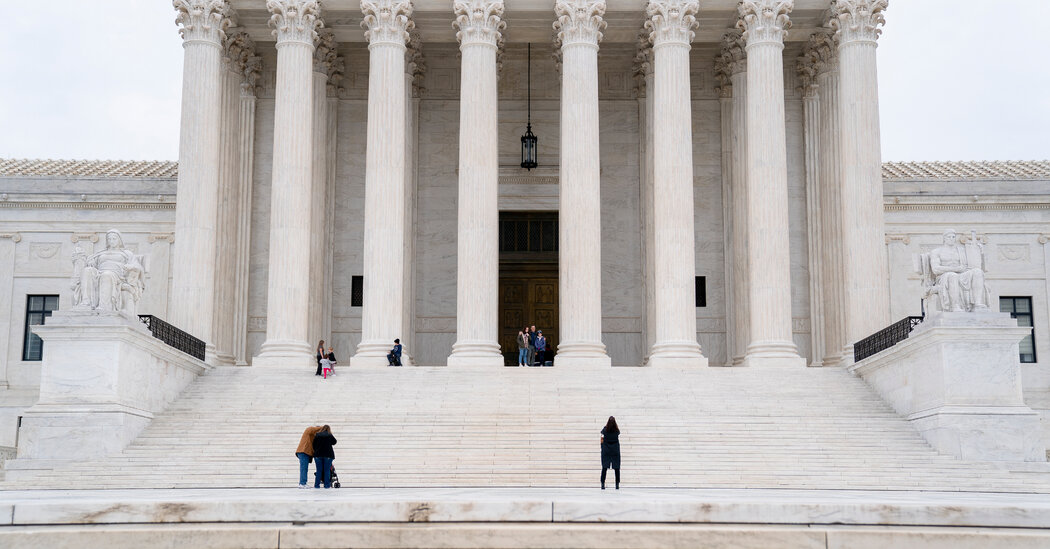
WASHINGTON — In 1973, in Roe v. Wade, the Supreme Court drew a line. The Constitution, it said, did not allow states to ban abortions before the fetus could survive outside the womb.
On Wednesday, when the court hears the most important abortion case in a generation, a central question will be whether the court’s conservative majority is prepared to erase that line. The case concerns a Mississippi law that bans most abortions after 15 weeks, long before fetal viability.
The court could overrule Roe entirely, allowing states to ban abortions at any point. But at least some justices may want to find a way to sustain the Mississippi law without overturning Roe in so many words, requiring them to discard the viability line and replace it with another standard that would allow a cutoff at 15 weeks.
Lawyers for Mississippi, who mostly argued that there is no constitutional justification for any line at all, did propose two backup arguments. They said the court could revise another existing standard, one prohibiting an “undue burden” on the right to abortion, to allow the 15-week cutoff by focusing on the fact that a substantial majority of abortions take place by then. Or, the lawyers wrote, the court could simply uphold the Mississippi law and leave for another day the knotty problem of drawing a new line.
Neither argument was serious, lawyers for Mississippi’s only abortion clinic responded. “The state offers no alternative to the viability line that could sustain a stable right to abortion,” they wrote.
Viability is supported by a principle in a way that other cutoffs are not, said David S. Cohen, a law professor at Drexel University.
“That is a point in time at which interests shift, because there is a medical justification for intervention in a way that would be different before viability,” he said. “If the court were to go backward in time without overruling Roe and say 15 weeks is now the new cutoff, I’m not sure what basis there would be for that.”
At the same time, drawing the line at viability has long been the subject of criticism. “The viability framework has always been something of an embarrassment, in large part because viability hinges on medical technology and access to it,” said Julia D. Mahoney, a law professor at the University of Virginia.
When Roe was decided, viability was around 28 weeks. These days, depending on the hospital, fetuses can survive outside the womb after around 23 weeks.
“Viability has come in for criticism from some bioethicists, both pro-choice and pro-life, essentially on the theory that it doesn’t track our moral intuitions of when life takes on value to focus exclusively on dependency, especially if dependency tracks technological development or even technological availability,” said Mary Ziegler, a law professor and historian at Florida State University.
The Supreme Court considered other approaches in Roe itself.
Justice Harry A. Blackmun, who wrote the majority opinion, initially chose another place to draw the line, at around 13 weeks.
“I have concluded that the end of the first trimester is critical,” he wrote to the other justices in 1972. “This is arbitrary, but perhaps any other selected point, such as quickening or viability, is equally arbitrary.” (“Quickening” is when a woman becomes aware of fetal movements, often around 16 weeks.)
Justice Thurgood Marshall helped persuade his colleague to choose viability, around the end of the second trimester. “Given the difficulties which many women may have in believing that they are pregnant and in deciding to seek an abortion,” Justice Marshall wrote to Justice Blackmun, “I fear that the earlier date may not in practice serve the interests of those women, which your opinion does seek to serve.”
The line Roe ultimately drew has been questioned.
Sherry F. Colb, a law professor at Cornell who was a law clerk to Justice Blackmun, recently wrote on a law blog that viability “would appear to have little to recommend it as a border between prohibiting and permitting abortion.” As a practical matter, she wrote, viability is a function of the ability to breathe outside the womb.
“The ability to breathe is essential for life,” she wrote, “but it is not the sort of thing to which we attach moral status, any more than the ability to see or to walk or to speak are such abilities.”
She also questioned the logic of viability as a standard for allowing a pregnant woman to seek an abortion.
“She can take the fetus out when it needs to be in but once it can survive an exit, it must stay in,” Professor Colb wrote. “What kind of a rule is that?”
Professor Mahoney said the approaches of other countries provided another point of comparison. Nominal limits of around 12 weeks are commonplace in other developed nations, though the social context is usually quite different. There are often few obstacles to obtaining abortions abroad, and public insurance is commonplace.
In the United States, the Supreme Court has repeatedly reaffirmed viability as the line required by the Constitution. In 1992, in Planned Parenthood v. Casey, which established that states could not place an “undue burden” on women seeking abortions before fetal viability, the court said viability was part of Roe’s “essential holding.”
“The woman’s right to terminate her pregnancy before viability is the most central principle of Roe v. Wade,” the controlling opinion in Casey said.
“We must justify the lines we draw,” the opinion said. “And there is no line other than viability which is more workable.”
Just last year, in providing the fifth vote to strike down a restrictive Louisiana abortion law, Chief Justice John G. Roberts Jr. underscored the point, quoting from the Casey decision.
The two sides in the Mississippi case have taken nearly absolutist positions. Lawyers for the state spent all but the last few pages of their main Supreme Court brief on a frontal attack on Roe and Casey, saying they were “egregiously wrong” and should be overruled, allowing states to ban abortions at any time.
The brief’s final pages did propose two approaches that would allow the Supreme Court to uphold the Mississippi law but avoid overruling Roe.
Understand the Supreme Court’s Momentous Term
First, the state’s brief said, “the court could hold that the state’s interests in protecting unborn life, women’s health and the medical profession’s integrity are, at a minimum, compelling at 15 weeks’ gestation” and “leave for another day the question of what standard applies in the absence of a viability rule.”
Second, the brief said, the court could transform Casey’s “undue burden” standard to allow outright bans on abortions before viability if they do not impose a substantial obstacle to a significant number of women seeking abortions. Since most women obtain abortions in the first trimester and the sole abortion clinic in Mississippi performs abortions until 16 weeks, the brief said, the law does not impose an undue burden.
Lawyers for the clinic responded that sustaining the state’s law was impossible to reconcile with Roe and Casey.
“There are no half measures here,” the clinic’s brief said. “Every version of the state’s argument amounts to the same thing: a request that the court scuttle a half-century of precedent and invite states to ban abortion entirely.”
Professor Cohen sounded a note of caution, saying that merely upholding the Mississippi law was not tantamount to overruling Roe v. Wade.
“If people are still able to get 95 percent of the abortions that happen in this country at 15 weeks or before, that’s still very significant,” he said. “That’s not Roe being overturned. Roe being chipped away? Yes. But Roe being overturned means that no abortions are legal in a state.”
Some members of the Supreme Court’s conservative majority may be tempted to look for a half measure, one that would undermine Roe and Casey without expressly overruling them.
Casey itself revised Roe in ways that supporters of abortion rights had said would amount to overruling Roe. When the Casey case was argued, Kathryn Kolbert, a lawyer for a group of abortion clinics challenging a Pennsylvania law, told the justices that abandoning the demanding form of heightened judicial scrutiny required by Roe and replacing it with “a less protective standard such as the undue burden test” would “be the same as overruling Roe.”
The court did abandon such heightened review, and it did replace it with the now familiar undue burden test, under which the court has sustained restrictions on abortion. Yet few people would say that Casey overruled Roe.
Some legal experts wonder if the court can make a similar move in the new case, Dobbs v. Jackson Women’s Health Organization, No. 19-1392.
“One of the questions many of us will be interested in is whether it’s possible to sever viability from Roe and Casey and have anything left — if the court can pull off the trick it did in Planned Parenthood v. Casey, when it eliminated what many viewed at the time as the core of Roe v. Wade and yet preserved what it deemed to be the essential holding,” Professor Ziegler said.
Professor Mahoney said that at least some of the justices may be inclined to try.
“We draw lines all the time in constitutional adjudication,” she said. “We have no choice. And we recognize that they are not entirely satisfactory.”






